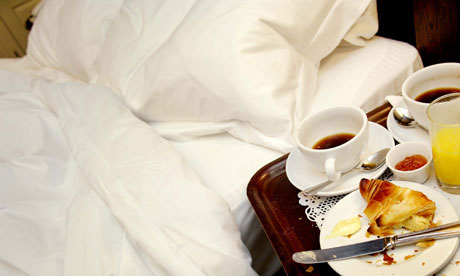
Drinking coffee, hard exercise and nose-blowing are the everyday activities most likely to raise blood pressure and cause a specific kind of stroke, doctors say.
Taken together, the three activities account for nearly a quarter of all cases in which a blood vessel bursts in the brain, a serious medical emergency that kills an estimated 1,800 people in Britain every year.
They topped a list of eight "triggers" that could rupture aneurysms – bulges in the walls of blood vessels – in the brain. The other triggers were sex, straining on the toilet, drinking cola and being startled or angry. Each activity causes a sudden, often brief, surge in blood pressure.
Between 1% and 6% of the UK population has a brain aneurysm, according to NHS estimates. Most occur in blood vessels at the base of the brain, but they tend to go unnoticed because they hardly ever cause symptoms. It is not clear what causes them, but a family history of aneurysms, high blood pressure and smoking are all risk factors.
Although brain aneurysms burst only rarely, a rupture causes bleeding and often fatal brain damage. Around a third of patients with a brain haemorrhage die within a month, and some 15% will require long-term care in nursing homes. Roughly one in ten recovers well enough to return to an active life.
Doctors created the list after asking patients and their carers to complete a questionnaire on what they were doing shortly before they had a stroke, and comparing their answers with the person's usual routine. The findings are expected to help with strategies to prevent strokes, for example advising people at risk to reduce their coffee intake or strenuous exercise.
"One of the major reasons we did this study was to understand better why some aneurysms burst and others don't," said Ale Algra, a clinical epidemiologist at the Utrecht Stroke Centre and the Julius Centre for Health and Primary Care in Utrecht, the Netherlands. "We wanted to know if there were specific triggers behind these events."
The researchers spent three years collecting information from 250 patients over 18 years old who had experienced a burst aneurysm in their brain. The team, led by Monique Vlak, a neurologist at the University Medical Centre in Utrecht, then worked out what fraction of haemorrhages in the wider population could be attributed to each activity.
Of the eight triggers, drinking coffee within the past hour was most strongly linked with ruptured aneurysms, accounting for an estimated 10.6%, with vigorous exercise at 7.9% and nose blowing at 5.4%. These were followed by sex (4.3%), straining on the toilet (3.6%), drinking cola (3.5%), being startled (2.7%) and being angry (1.3%). Both cola and coffee contain caffeine, which can raise blood pressure.
The study is published in the journal Stroke.
"For patients who know they have an intracranial aneurysm, it might be an advantage to avoid coffee and avoid straining to defecate by using laxatives if needed," Algra said.
Some patients discover they have an aneurysm after having a brain scan for another medical reason. Aneurysms can be operated on, either by clipping the bulge shut, or filling the aneurysm with thin wire coils, but some are hard to reach, making the operation a major risk in itself.
"The rupture of a brain aneurysm is incredibly dangerous. It is often sudden, without warning, and it can cause bleeding in the brain, known as a haemorrhagic stroke. A sudden surge in high blood pressure can increase the likelihood of an aneurysm rupturing," said Sharlin Ahmed at the Stroke Association.
"However, it's very difficult to determine whether the triggers identified in this study are definitely related to the onset of a stroke as they could simply be put down to coincidence. A lot more research needs to be carried out to assess whether each of the identified triggers could directly cause an aneurysm to rupture."

